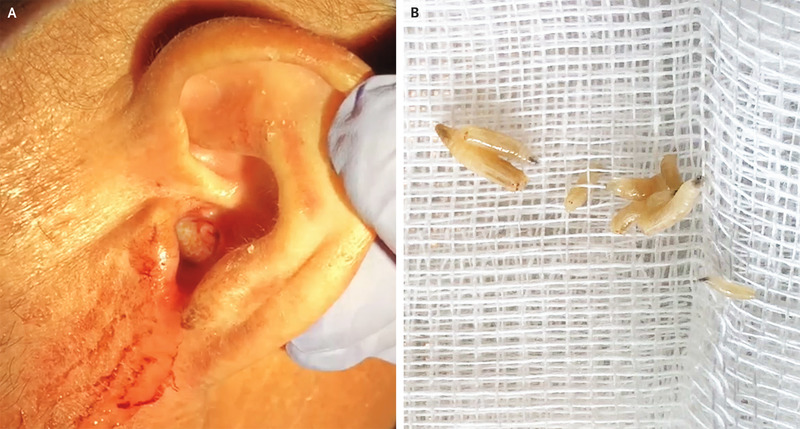Maggots were discovered in a man's ear after he was taken to a hospital in Portugal moaning of discomfort, itching, and bleeding. After enduring symptoms for five days, the 64-year-old was admitted to the hospital. Doctors at Hospital Pedro Hispano in Matosinhos documented the unusual instance in a study published in The New England Journal of Medicine on November 24.
A physical inspection revealed that "many mobile larvae" were clogging the man's eardrum. The physicians removed the larvae with ear forceps after irrigating the ear using water. They also discovered that the larvae had pierced a tiny part of the eardrum.
The larvae have cylindrical, segmented bodies that are whitish golden in hue and are consistent with the species Cochliomyia hominivorax as mentioned by Catarina Rato, a co-author of the report and one of the physicians treating the patient. C. Hominivorax, often commonly known as the New World screwworm fly, is a pathogenic fly that deposits its eggs on other creatures and feeds the larvae on their flesh. Myiasis is the medical term for this ailment.
Eggs Into Larvae
As stated in a California Department of Food and Agriculture data sheet on the species, each female fly will lay up to 400 eggs in the tissues of animals, mainly warm-blooded ones, following which the eggs hatch into larvae. The larvae dig into the tissue, eating on their host's flesh and "screwing" further if the incision is disturbed, a distinctive screwworm habit that can destroy the tissue as well as lead to infections. If such situations go untreated, they can be lethal.
After five to seven days of eating, the larvae plunge to the ground, burrowing into the earth, and pupate for another three- to five days before emerging as adults. The fly is mainly encountered in Central and South America as well as in a few Caribbean islands including Jamaica and Cuba, as stated by Parasite and Vectors.
Rato claimed that the patient from Portugal received antibiotic ear injections, boric acid solution, and oral antibiotics. Antibiotics and steroids are used in eardrops to prevent bacterial infection and reduce swelling and inflammation while boric acid provides an alkaline condition in the ear that is unfriendly to microbial development.

Images show New World screwworm fly larvae inside a Portuguese man's ear (left) and after being removed (right). The larvae had damaged part of his eardrum.
Human Infection
Myiasis in humans is uncommon in the United States, although it is rather frequent throughout tropical and subtropical locations with low socioeconomic status. According to the US Centers for Disease Control and Prevention (CDC), people from the US are more likely to become sick when abroad, with individuals who have untreated open wounds being the most vulnerable.
Infections can occur anywhere on the body. Doctors revealed an instance of a 7-day-old child with 55 larvae invading its umbilical cord in 2020. In this example, the infant was given ivermectin at the wound site, which incapacitates the parasite as well as kills the larvae.
Following the paper, the places most vulnerable to parasite infection include the mouth, all open wounds, the scalp, and natural orifices such as the ears, nose, and genitals. Surgery may be necessary to remove the larvae if they are dead or rotting in deep tissues.
Rato described the individual with the contaminated ear as having aural myiasis, a rare and distinct clinical condition. Chronic otitis media [recurrent ear infection], diabetes, drunkenness, low socioeconomic position, and swimming in stagnant water are the most prevalent risk factors. A seven-day examination revealed that the patient seemed to have no larvae.
RELATED ARTICLE: Black-Dotted Maggot-Like Parasites Found Wriggling Out of Woman's Arms After Months of Skin Irritation
Check out more news and information on Medicine and Health in Science Times.




![Earth's Quasi-Moon Kamo‘oalewa Could Originate From Lunar Surface Not Asteroid Belt [Study]](https://1721181113.rsc.cdn77.org/data/thumbs/full/53275/89/56/50/40/earths-quasi-moon-kamo-oalewa-could-originate-from-lunar-surface-not-asteroid-belt-study.png)









